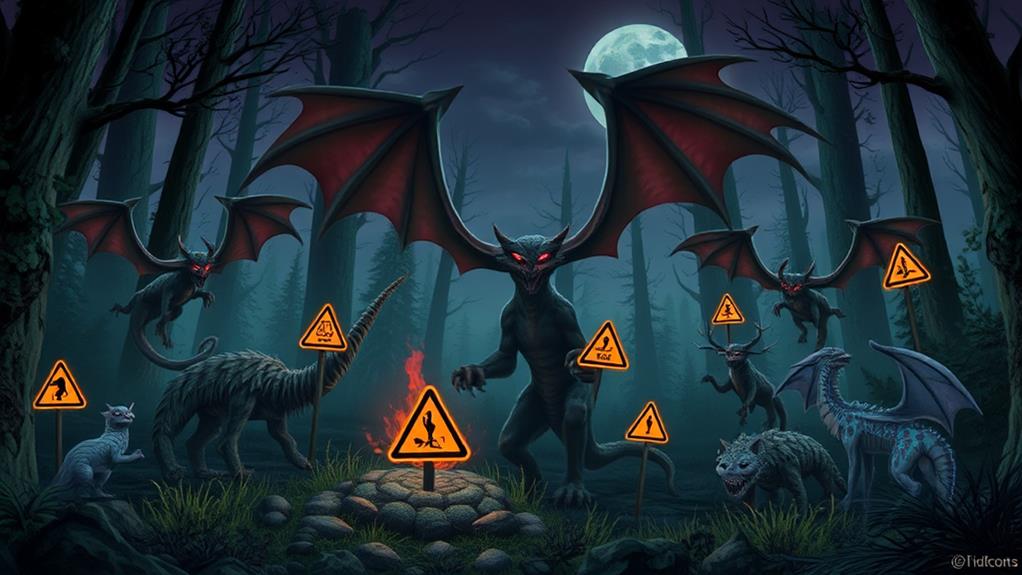
To tame a magical beast effectively, start by researching its natural habitat, diet, and behaviors. Establish trust by moving slowly, using a calm voice, and offering treats. Wear enchanted protective gear and use a proper containment tool like a mystical barrier. Teach basic commands and maintain consistency with rewards and boundaries. Recognize warning signs and prioritize safety by creating a secure, hazard-free environment. Regular, short training sessions are crucial, paired with patience and consistency. Seek expert guidance to avoid mistakes and accelerate learning. By mastering these steps, you can cultivate a strong bond and keep mastering your taming skills.
Understand Your Beast

When taming magical beasts, understanding your beast is crucial. Each creature has unique characteristics, behaviors, and needs. Start by researching its natural habitat, diet, and social structure. Knowing these details helps you anticipate its reactions and handle it more effectively. For instance, a Hippogriff requires respect and a specific gesture to approach safely, while a Niffler's obsession with shiny objects means you'll need to secure your valuables.
Observe your beast closely. Pay attention to its body language and vocalizations. These cues often indicate its mood and intentions. A dragon, for example, might flick its tail when agitated, warning you to keep your distance. Recognizing these signs early can prevent dangerous situations.
Additionally, consider the magical properties of your beast. Some creatures possess abilities that can influence their behavior. A Phoenix's regenerative powers might make it more fearless, while a Thestral's invisibility could complicate your training efforts. Understanding these traits allows you to tailor your approach accordingly.
Lastly, remember that patience is key. Each magical beast has its own pace for building familiarity and comfort. Rushing the process can lead to setbacks, so give your beast the time it needs to adjust.
Establish Trust Early
Building trust early with a magical beast sets the foundation for a successful taming process. When you first encounter a magical creature, keep your movements slow and deliberate. Avoid sudden gestures that might startle it. Speak in a calm, steady voice to reassure the beast of your intentions.
Offer the creature a token of goodwill, such as a favorite treat or a soothing charm. This small gesture can go a long way in showing that you mean no harm. Make sure to respect its space; let the beast approach you when it feels ready. Patience is key here.
Observe the beast's body language closely. Signs of relaxation, like a lowered head or a softened gaze, indicate growing trust. Respond positively to these signs by offering gentle, non-threatening touches. Never force contact; let the beast set the pace.
Consistency is vital. Regular, positive interactions build a stable relationship and reinforce the trust you've started to establish. Be present and attentive, showing the beast that you are reliable and caring. Over time, these consistent, respectful interactions will create a strong bond, easing the taming process noticeably.
Use Proper Equipment

Using proper equipment is crucial when taming magical beasts. The right gear guarantees your safety and helps you communicate effectively with the creature. First, always wear enchanted protective clothing. These garments can shield you from elemental attacks, sharp claws, and even minor spells. Next, invest in a reliable containment tool, such as a reinforced cage or a mystical barrier. These should be strong enough to hold your magical beast without causing it distress.
Don't forget a good-quality wand or staff, ideally one attuned to the specific type of beast you're working with. This tool helps you cast calming spells or create barriers quickly if things get out of hand. A specialized harness or leash, imbued with enchantments, can also be useful for guiding and restraining the creature without harming it.
Lastly, carry a basic first aid kit designed for both humans and magical creatures. It should include healing potions, bandages, and a few universal antidotes. Proper equipment not only protects you but also builds a foundation of trust and respect between you and the magical beast. With these tools, you're well-prepared to handle any situation that arises.
Learn Basic Commands
Proper equipment in hand, the next step is to learn basic commands to effectively communicate with your magical beast. Establishing a clear set of commands is essential for ensuring both safety and cooperation. Start with simple, universally understood commands like "sit," "stay," and "come." These foundational instructions form the building blocks for more complex interactions.
Use consistent verbal cues and pair them with distinct hand signals. This dual approach helps reinforce the command, making it easier for your magical beast to comprehend and remember. For example, a raised palm for "stay" or a pointed finger for "come." Consistency is key; always use the same word and gesture for each command.
Positive reinforcement is vital when teaching commands. Reward your magical beast with treats, praise, or a gentle pat when they successfully follow an instruction. This encourages them to repeat the behavior and helps build a trusting relationship.
- Use Verbal Cues and Hand Signals: Combine words with gestures for clearer communication.
- Stay Consistent: Always use the same words and gestures for each command.
- Practice Positive Reinforcement: Reward good behavior to encourage learning.
Be Patient and Consistent

Mastering the art of taming magical beasts requires you to be patient and consistent. These creatures, often unpredictable and powerful, need steady guidance to understand your expectations. Consistency in your actions and commands builds trust and familiarity, essential elements for effective training. When you set boundaries, guarantee they remain the same every day. If you allow a magical beast to break a rule once, it'll expect the same leniency again, complicating future training sessions.
Patience is equally imperative. Magical beasts might not grasp commands instantly. They'll test your resolve, pushing boundaries to see how you react. By staying calm and composed, you demonstrate that you're in control. Over time, your patience will pay off as the beast begins to respond positively to your training.
Reward Good Behavior
Rewarding good behavior is essential in the process of taming magical beasts. When your magical beast exhibits positive actions, immediately acknowledge and reward it. This reinforces the behavior, making it more likely to be repeated. The key is to be consistent and prompt, so your magical beast associates the reward with the good behavior.
Small treats, verbal praise, and affection can go a long way. Always have a stash of their favorite snacks, and use a happy, encouraging tone when they do something right. Physical affection, like gentle petting or a scratch behind the ears, can also be very effective.
Consider these suggestions to make the process enjoyable:
- Vary the rewards: Keep things interesting by mixing up treats, toys, and praise.
- Use a reward system: Develop a point system where certain behaviors earn more points, leading to bigger rewards.
- Personalize rewards: Understand what your magical beast loves most, and tailor the rewards to those preferences.
Recognize Warning Signs

While rewarding good behavior is a key part of taming magical beasts, it's equally important to recognize warning signs. Magical beasts often exhibit subtle cues before they become aggressive or unmanageable. Pay close attention to changes in their eyes, posture, and vocalizations. A sudden narrowing of eyes or a low growl can indicate irritation or distress. If a beast's tail starts whipping back and forth or its feathers puff up, take these as serious warnings.
Body language isn't the only indicator. Watch for environmental cues as well. If a creature begins to mark its territory more aggressively or starts avoiding certain areas, it could be a sign of discomfort or brewing hostility. Watch for changes in eating habits; a magical beast that's suddenly uninterested in its favorite food might be unwell or stressed.
Recognizing these signs early allows you to intervene before the situation escalates. Implement calming techniques like soft-spoken words or gentle gestures to ease their anxiety. By staying vigilant and understanding these warning signs, you can maintain a harmonious relationship with your magical beast. Remember, being proactive makes all the difference in taming and coexisting peacefully.
Maintain a Safe Environment
Creating a safe environment is essential when taming magical beasts. You need to guarantee that both you and the creature are protected. Start by evaluating the space where you'll interact with the beast. Remove any sharp objects or potential hazards that could cause harm. Remember, magical beasts can be unpredictable, so it's imperative to minimize risks.
You should also establish barriers or containment areas. These can be magical wards, enchanted fences, or even simple physical barriers, depending on the beast's nature. This not only keeps the creature from escaping but also protects others from accidental encounters.
Moreover, always have emergency measures in place. This includes knowing the nearest exit, having a first aid kit on hand, and understanding the beast's weaknesses or calming techniques. Preparing for the unexpected can make all the difference.
To help you maintain a safe environment, consider these tips:
- Remove hazards: Clear the area of any dangerous objects.
- Set up barriers: Use physical or magical barriers to contain the beast.
- Prepare emergency measures: Know exits, have a first aid kit, and calming methods ready.
Practice Regular Training

Once you've guaranteed a secure environment, the next step is to practice regular training with your magical beast. Consistency is key. Set a daily schedule and stick to it; magical creatures thrive on routine. Begin with basic commands, like "sit" or "stay." Use clear, firm words and maintain eye contact. Reward compliance with treats or affection to reinforce good behavior.
Training sessions should be short but frequent—15 to 20 minutes, twice a day, works well for most magical beasts. Longer sessions can lead to frustration for both you and the creature. Always end on a positive note to keep your beast motivated for the next session.
Understand your magical beast's unique abilities and traits. A fire-breathing dragon will have different training needs compared to a shape-shifting pixie. Tailor your approach to suit their specific characteristics. Use tools like enchanted collars for safety and control but avoid overly restrictive equipment that might distress your creature.
Stay patient and observant. Magical beasts can be unpredictable, so adapt your techniques as needed. If your beast shows signs of stress or aggression, take a break and reassess your methods. Regular practice will build trust and pave the way for a harmonious relationship.
Seek Expert Guidance
When taming magical beasts, seeking expert guidance can make a substantial difference in your success. Experts have years of experience and a wealth of knowledge that can help you avoid common pitfalls and master advanced techniques. They can provide personalized advice tailored to your specific situation, ensuring you’re on the right path from the start. Additionally, working with experts often allows you to uncover the mysteries of magic revealed through their seasoned insights and unique approaches. Their mentorship can inspire confidence as you navigate the complexities of bonding with magical beasts, fostering a deeper understanding of their behaviors and needs. With their guidance, not only will you enhance your taming skills, but you’ll also build meaningful connections with the creatures you seek to guide. Moreover, many experts can also offer valuable insights into related aspects of the magical world, such as wizarding school scholarship advice that can help aspiring tamers gain access to prestigious institutions. This guidance can open doors to advanced training and resources that are essential for honing your skills. By blending the art of taming with academic prowess, you create a well-rounded approach that prepares you for the challenges of working with magical beasts.
Finding the right expert might seem intimidating, but it's worth the effort. Look for someone with a proven track record and positive testimonials. Don't hesitate to ask for references or observe them in action before committing to their guidance. Also, consider joining magical beast taming communities or forums where experts frequently offer advice and answer questions.
- Avoid Costly Mistakes: Experts can help you sidestep errors that might harm you or your magical beast.
- Accelerate Learning: With expert tips and tricks, you'll quickly grasp complex techniques that would take much longer to learn on your own.
- Boost Confidence: Knowing you have an expert to turn to can markedly enhance your confidence and reduce anxiety.
At a Glance
Taming magical beasts can be a thrilling adventure, but it requires dedication and care. Remember, understanding your creature and establishing trust are vital first steps. Equip yourself properly, learn basic commands, and remain patient and consistent. Recognize warning signs and maintain a safe environment to avoid mishaps. Regular training and seeking expert guidance guarantee success. So, are you ready to set out on this magical journey with confidence and skill? Happy taming!






